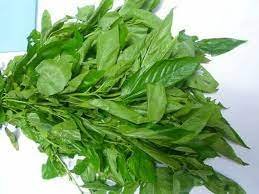Nutrition
Health benefits of jute leaves (Ademe)

• Jute leaves
Jute leaves is popularly called ewedu among the Yoruba and rama or ayoyo among the Hausa. It is a popular vegetable in West Africa and is not just rich in nutrition but also has a lot of health benefits, including protecting us from various diseases. Nutrition-wise, vegetables are low in calories but high in vitamins and minerals.
– Internal Bleeding
Jute plant consists of considerable amount of Vitamin K which is helpful in reducing the threat of bleeding in the liver, poor nutrient absorption, jaundice or the combination of long term use of antibiotics or aspirin. Some of the problems related with the gastrointestinal system due to a decrease of this vitamin include colitis, obstructions, sprue and Crohn’s disease. All these problems are due to a reduced content of Vitamin K.
-Weight loss
The green leaf has been described as a source of weight loss. Serving ayoyo or ademe without meat or fish has 97 calories. So, for those trying to lose some weight, include ewedu in your diet.
The ewedu leaf is an adequate source of fibre, thus making the plant very helpful in dealing with weight management and may also promote intestinal health by helping with bowel movement.
– Good for pregnant
women
This jute leaf has been known to be a remedy for pregnant women experiencing prolonged labour. When a pregnant woman is experiencing prolonged labour, a bunch of ewedu leaves squeezed with the stem can be given to her to drink. It has also been discovered to aid milk secretion in lactating mothers.
– Protects Eye Health
Poor diet or nutrient deficiencies are the fundamental reasons of numerous eye diseases. Research has proven that taking vitamin B6 together with other vitamins, like folate, can help in the prevention of eye disorders and loss of vision. Jute plant consists of 0.496 mg Vitamin B6 which is 38.15percent of the daily recommended value. Regular consumption of Jute plant is believed to help slow the start of certain eye diseases, including age-related macular degeneration.
-Fights off colds and flu
Jute plant consists of Vitamin C which is extremely beneficial to the immune system and plays an important role in the body’s ability to fight off colds and viruses. You can take 1,000 mg of Vitamin C to fight off an oncoming cold and 4,000 mg per day to get rid of a cold which is previously in your system.
Vitamin C when taken during colds and flu can help to decrease the risk of developing further complications, like pneumonia and lung infections.
-Reduces cholesterol
Several research studies have shown that copper helps to reduce the levels of “bad” cholesterol (LDL cholesterol) and to increase beneficial cholesterol (HDL cholesterol). Jute plant consists of 0.222 mg of copper which is 24.67percent of the daily recommended value. This helps to lower the chances of cardiovascular diseases like atherosclerosis, heart attacks, and strokes.
– Protects healthy hair and skin
Vitamin B2 also known as riboflavin plays an important role in maintaining collagen levels, which helps to make up healthy skin and hair. Collagen is required to maintain the youthful structure of skin and to prevent fine lines and wrinkles, thus a riboflavin deficiency can make us look aged earlier. Some research recommends that riboflavin can decrease the time needed for wound healing, can decrease skin inflammation and cracked lips, and can help naturally slow signs of aging.
Source: Herbal Cure For Disease
Nutrition
Galamsey: Stealing nutrition from Ghana’s children

On the banks of the River Pra, Ama, a mother of three, points to the murky water flowing past her village. “We used to drink from this river. We used to fish here,” she says. “Now, even our crops die when we use it to water them.” Ama’s children rarely eat fish anymore, and vegetables from her once-fertile farm are scarce. Their daily meals now consist mostly of cassava and a little palm oil which is filling, but far from nutritious.
Ama’s story is not unique. Across Ghana’s mining communities, illegal small-scale mining, or galamsey, is robbing families of the very resources they need to eat well and stay healthy. The focus of public debate has often been on the destroyed forests, poisoned rivers, and billions lost in gold revenue. But beneath the surface lies a quieter tragedy: a nutrition crisis with lasting consequences for Ghana’s children.
With rivers poisoned by mercury and cyanide, farming and fishing have collapsed in many galamsey zones. Families that once relied on fish as a key source of protein now go without. Crops watered with polluted streams fail to thrive, while fertile cocoa and vegetable farms have been dug up and abandoned. With food production disrupted, prices climb, and poor households are forced to rely on cheap, starchy meals with little nutritional value.
The impact is already showing. Health workers in mining areas report higher cases of child stunting, anaemia among women, and underweight children compared to farming districts. Pregnant women face greater risks during childbirth, while children raised on nutrient-poor diets struggle with growth, learning, and long-term productivity.
The problem stretches far beyond the mining pits. When rivers like the Pra, Ankobra, and Offin are polluted, irrigation systems and fisheries downstream are also destroyed, threatening food supplies in entire regions. In the long run, galamsey doesn’t just damage land, it undermines Ghana’s fight against hunger, malnutrition, and poverty.
If Ghana is serious about protecting its people, tackling galamsey cannot be seen only as an environmental or economic battle. It must also be seen as a public health and nutrition emergency. Safeguarding rivers and farmland means safeguarding the right of every child to eat a balanced diet and grow to their full potential.
Ama’s children, and thousands like them, deserve more than poisoned water and barren fields. They deserve safe food, clean water, and a future free from malnutrition. Ending galamsey is not just about saving the land; it is about saving Ghana’s nutritional future and the next generation.
We call on government to deploy multi-sector response teams that include health and agriculture officials, establish mobile nutrition clinics in affected areas, and mandate nutrition impact assessments for all mining permits. We urge traditional authorities and assemblies to enforce local bylaws and support community-led river monitoring systems.
We challenge citizens to demand quarterly transparency reports on galamsey enforcement and nutrition indicators from their MPs and district assemblies and we encourage the media to continue investigating the financial networks behind illegal mining. Ghana has the laws and resources, what’s missing is the political courage to enforce them. Ama’s village, and countless others like it, cannot wait any longer.
Feature Article by Women, Media and Change under its Nourish Ghana: Advocating for Increased Leadership to Combat Malnutrition Project
Join our WhatsApp Channel now!
https://whatsapp.com/channel/0029VbBElzjInlqHhl1aTU27
Nutrition
Accountability in Nutrition: Who holds Ghana’s leaders responsible?
Ghana’s fight against malnutrition is undermined not by a lack of knowledge, but by lack of accountability.
Nutrition experts and policymakers alike know what works: exclusive breastfeeding, micronutrient supplementation, food fortification, school feeding programs, and nutrition-sensitive agriculture.
Yet, programs stall, targets are missed, and resources are underfunded with little consequence for those responsible.
Who is responsible when exclusive breastfeeding stagnates below global targets? Who answers for the fact that nearly half of Ghanaian women suffer from anaemia despite repeated pledges to improve maternal nutrition? Who explains why stunting rates remain at 18 percent when the target was 15percent by 2025? Who ensures that Nutrition for Growth (N4G) commitments made at the international stage are translated into local budgets and services? Who accounts for nutrition budgets that fall short of the 2-3 percent allocation recommended for effective programming? Etc.
Accountability must be made non-negotiable. Parliament must demand annual nutrition accountability reports from the Ministry of Health, the Ministry of Agriculture, and the National Development Planning Commission (NDPC), tracking not only policy promises but also tangible outcomes.
The NDPC, as the apex planning body, must take the lead in monitoring nutrition indicators across all sectors and ensuring that district-level plans integrate nutrition targets.
Civil society must step up, using evidence and data to spotlight the gaps between rhetoric and reality. Tools such as nutrition scorecards and citizen report cards can empower communities to track progress and demand answers. Media outlets must treat nutrition as a governance issue, not just a health story buried in lifestyle pages.
District assemblies, as the frontline implementers of nutrition programmes, must be held accountable for translating national policies into community-level action. They should report regularly on the status of school feeding programmes, community-based management of acute malnutrition (CMAM) services and local food security initiatives.
The public also has a role to play. Citizens must demand better interventions that addresses their nutritional needs, by asking their representatives what concrete steps have been taken to improve nutrition in their communities. Communities can use vox pops, community radio, and grassroots dialogues to hold leaders accountable. The Food Systems Transformation and Nutrition Security (FSTNS) Cross-Sectoral Planning Group (CSPG), led by the National Development Planning Commission (NDPC), which serves as Multi-Sectoral Platform for Food Security and Nutrition should serve as a coordination hub where stakeholders review progress and identify bottlenecks in real time.
International partners must not shy away from asking tough questions about financing gaps and delayed reforms. Accountability should have teeth, public hearings for nutrition budget performance, independent audits of feeding programmes and performance-based funding mechanisms that reward results, not just promises.
Countries like Rwanda have shown that strong political commitment backed by rigorous accountability mechanisms can dramatically reduce malnutrition rates. Ghana can learn from such examples, adapting successful models to our own context.
Without accountability, nutrition will remain a political talking point instead of a development reality. Ghana cannot afford empty commitments. Our children deserve measurable results, and our leaders must be held responsible for delivering them.
Feature Article by Women, Media and Change under its Nourish Ghana: Advocating for Increased Leadership to Combat Malnutrition Project
Join our WhatsApp Channel now!
https://whatsapp.com/channel/0029VbBElzjInlqHhl1aTU27

 Profile6 days ago
Profile6 days agoAlbert Litela Obidiaba: The artist who wove Ghana’s soul into the King’s Baton

 News6 days ago
News6 days agoDaddy Lumba’s wife, children run to court to injunct December 6 funeral arrangements

 News1 week ago
News1 week agoPresident Mahama to meet Auditor-General, Chief Justice and Attorney-General over misuse of public funds






